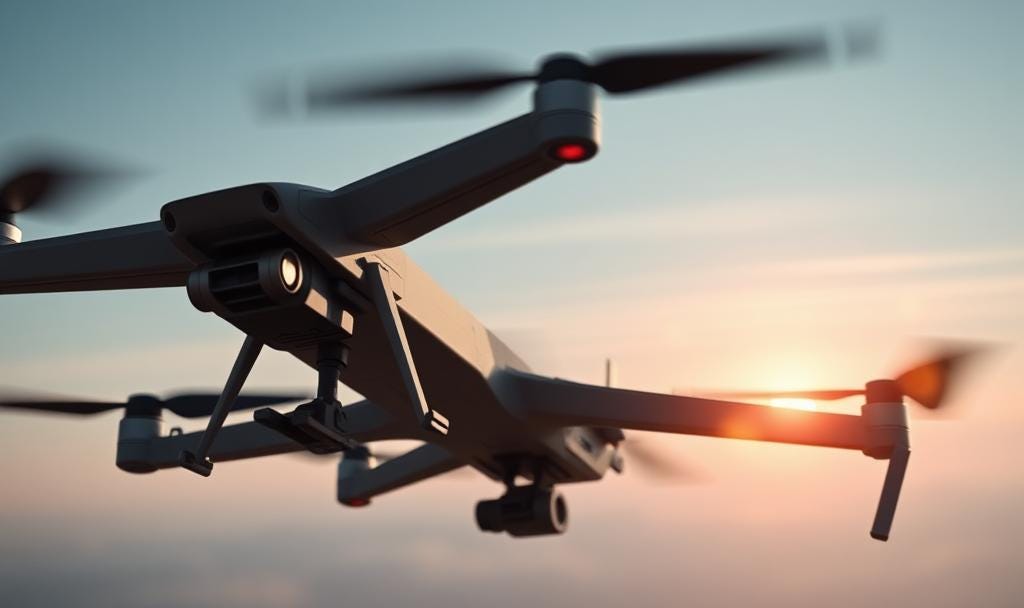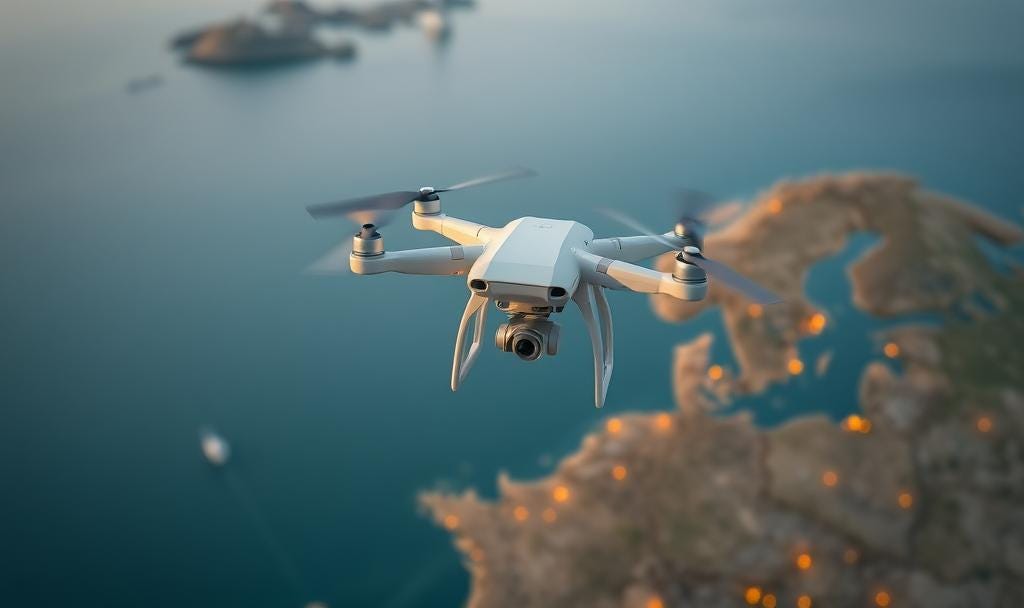Drone Dispatch
29 September - 5 October, 2025
Dronefare Weekly Drone Dispatch
Welcome to the Drone Dispatch, your dedicated source for staying ahead in the rapidly evolving world of drones and drone warfare. This newsletter brings together the latest developments in drones and drone warfare, from cutting-edge technology and tactical innovations to global military applications and policy shifts. Each dispatch is designed to provide a clear and concise overview of how drones are shaping modern conflict, international and domestic security, and strategy.
Executive Summary
EU leaders backed a plan for a border drone wall after new airspace incursions jolted NATO. Denmark’s recent violations pushed the issue to the top of the agenda, with calls for shared radar and anti-UAS networks across the continent.
Denmark tightened airspace rules during the 1-2 October Copenhagen summits, while Germany’s Munich Airport briefly shut down after drone sightings on 3 October, highlighting Europe’s growing civilian airspace vulnerability.
Manila recovered a Chinese underwater drone operating inside Philippine waters, adding friction to an already tense South China Sea.
Ukraine escalated deep strikes on Russian energy targets, while Russia’s 4 October attack on a Ukrainian passenger train killed civilians and drew condemnation from Kyiv and Western allies.
Poland moved to upgrade its counter-drone systems after repeated airspace breaches, seeking NATO support and faster procurement from Western defense firms.
Ukraine’s new frontline drone marketplace logged explosive growth, serving thousands of units with custom-built FPV drones and rapid repair kits.
Polish startup Orbotix raised €6.5 million to expand its autonomous drone-swarming technology across European defense networks.
Drone Warfare
Russian drone hit a passenger train in Ukraine (Oct. 4). The strike killed and injured over 30 civilians traveling near Kremenchuk. The attack marked another escalation in Russia’s effort to disrupt Ukraine’s rail logistics, one of the few reliable transport routes for moving troops and supplies.
Ukraine hit Russian oil infrastructure. Drones struck a major refinery in Russia’s Leningrad region, igniting large fires and disrupting production. Kyiv continued its push to hit military-linked energy assets deep inside Russia to reduce its war-sustaining capacity.
Philippines recovered a Chinese undersea drone (Oct. 1). The craft was found off Mindoro island and analyzed by the Philippine Navy. Officials said the drone likely gathered oceanographic data, but the find reinforced concerns over China’s persistent surveillance in regional waters.
Pakistani drone crossed into Indian border area (Oct. 4). Indian security forces in Jammu and Kashmir’s Samba district launched a night search and intercepted several payloads of contraband.
Israel used submarine-launched drones near Tunisia (Sept. 8–9). Prime Minister Netanyahu authorized drone operations targeting suspected Hamas-linked boats delivering supplies to Gaza. The unarmed vessels were turned back, and the episode demonstrated Israel’s continued reliance on autonomous naval systems for interdiction.
Civil aviation disruptions spread. The Munich Airport closed its runways on 3 October after pilots reported multiple drones near the approach paths. Flights were delayed for hours. Officials urged stronger coordination between civil aviation and law enforcement to manage the growing threats posed by drones.
Russia destroyed 13,000 pigs on a Ukrainian farm (Oct. 3). In a drone strike on a farm in Novovodolazka, Kharkiv region, Russian drones set fire to eight pig sheds, killing roughly 13,000 pigs and injuring one worker.
Drone Policy & Regulation
EU leaders rallied behind a continent-wide “drone wall.” In a meeting in Copenhagen on 1 October, EU leaders endorsed a framework for coordinated surveillance and counter-UAS systems that stretches from Finland to Romania. The plan will link sensors, jammers, and rapid-response teams to counter incursions from the east.
Zelenskyy offered Ukraine’s expertise to Europe (Sept. 29). The Ukrainian president proposed technical partnerships with Poland, the Baltics, and Denmark to help build the EU drone defense network. He said Ukraine’s wartime experience could shorten Europe’s learning curve in detection and response.
Poland sought stronger counter-UAS tech. After several incursions from Russian-origin drones, Warsaw announced new defense tenders for radar-linked interceptors and portable jamming systems. Defense officials emphasized the need for rapid procurement over long-term research and development to address current gaps.
Technology & Innovation
Ukraine’s sea drones launched fiber-optic “unjammable” drones. Engineers unveiled maritime drones that deploy smaller, fiber-optic-guided FPV (First Person View) craft, maintaining control even under heavy jamming. The system demonstrated near real-time targeting accuracy and could redefine naval engagements in the Black Sea.
Industry funding picked up. Orbotix, a Polish startup, raised €6.5 million to expand its autonomous swarming platforms. The firm aims to integrate cooperative drone behaviors, such as synchronized mapping and target tracking, into Europe’s military procurement pipeline.
Frontline logistics went digital. Ukraine’s DOT-Chain marketplace logged nearly 17,000 drone orders in under two months. It connects front-line units directly with small drone makers, cutting delivery times from weeks to days and allowing custom payload modifications per mission.
Outlook & Future Trends
Europe moved from rhetoric to rapid mobilization on drone defense, but unity remains fragile. Denmark and Poland want immediate protection, while France and Germany prefer a longer-term industrial strategy. Success will depend on interoperability and shared funding rather than isolated systems.
Technologically, fiber-optic guidance and autonomous swarm coordination are setting new standards for control resilience and coordination. Ukraine’s practical combat use is accelerating global adoption far faster than planned military programs anticipated.
The pig farm strike illustrates a dark trend: Russia is extending drone warfare into economic and agricultural targets. That means Europe must consider nontraditional countermeasures, such as enhanced surveillance of rural assets, defensive insurance for agribusinesses, and even drone-based firefighting systems to combat farm fires.
Expect to see “dual-use” expansion within civilian airports, shipping companies, and border guards adapting defense-grade counter-UAS tools for daily operations.
Thanks for reading Dronefare’s Weekly Drone Dispatch. Follow us on LinkedIn and subscribe to stay up-to-date on the latest developments in drone warfare.



